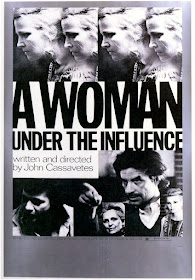I wish I could see the
qualities in John Cassavetes’ work that are so obvious to his admirers, but
having watched most of the major pictures in the writer-director’s revered
canon, I’m hung up on a few things. First, why are the movies so
self-indulgently long and repetitive? I get the idea of trying to capture
reality in all of its messy rhythms, but since Cassavetes edited his raw
footage, why didn’t he keep editing until scenes become concise? Did he really
believe everything his actors did was
interesting? Furthermore, isn’t there something inherently precious about the
whole concept of “capturing reality” anyway, seeing as how Cassavetes’ movies
feature actors? How true can pretending be? Finally, why are so many of
Cassavetes’ pictures filled with wall-to-wall ugliness? The implication seems
to be that the only genuine characters are those who are perpetually at each
other’s throats for craven reasons.
Anyway, I gave up trying to enjoy
Cassavetes’ movies a while ago, even though I admire his integrity; there’s no
question he showed nerve by shunning nearly everything one associates with
Hollywood filmmaking, from brisk pacing to smooth camerawork to tidy
resolutions. Consider: Around the time A
Woman Under the Influence was made, actresses including Ellen Burstyn and
Joanne Woodward were using their influence to make Hollywood movies featuring themes
similar to those found in A Woman
Under the Influence. Yet while the Hollywood productions starring Burstyn
and Woodward offered crisp explanations for why certain women behave
erratically, Cassavetes simply depicted a woman succumbing to unnamed mental
difficulties, leaving the viewer as bewildered as the afflicted woman’s loved
ones.
Is one approach better than the other? Who’s to say?
Cassavetes’ wife,
Gena Rowlands, plays Mabel, a Los Angeles housewife and the mother of three
young children. Her husband, Nick (Peter Falk), supervises a municipal road
crew, so he’s often called away unexpectedly. When the story begins, one of
Nick’s sudden absences knocks Mabel out of balance, so she cycles through
several types of odd behavior. She forgets facts she should know well, like the
names of Nick’s co-workers; she flirts recklessly and even brings a stranger
home one night; she explodes into screaming rages; and she humiliates Nick by
creating scenes in front of his family and friends. As in most of Cassavetes’
movies, these events are shown in long, shapeless scenes filled with seemingly
improvised discursions the camera captures with blurry, documentary-style
fluidity.
Rowlands gives a committed performance, but whether her acting
choices feel authentic or forced is open to debate. (The Academy of Motion
Picture Arts and Sciences praised her work with an Oscar nomination for Best
Actress.) For me, however, Falk’s characterization is a greater stumbling block
than Rowlands’. Watching him berate and lie to his wife, hearing him threaten
to kill his own children and those of his neighbor, and seeing him slap
Rowlands to the ground on two occasions, I kept wondering why everyone in the
movie regarded Rowlands’ character as
a lunatic. But then again, maybe that’s why I can’t find a place for myself in
Cassavetes’ cinematic world. Between the rampant misogyny and the tiresome
preoccupation with unmotivated anger, the director’s vision seems to be
focused myopically on the worst parts of the human experience.
A Woman Under the Influence: FUNKY


Me three. I couldn't take all Rowlands' weird tics and fidgets in this one. Give me Jill Clayburgh in AN UNMARRIED WOMAN any day!
ReplyDeleteI guess I'm me four. Picked this up about a month ago on a suggestion but lasted about 20-30 minutes into it. I bailed ship during the bizarre dinner scene....too weird even for my tastes.
ReplyDeleteMe five, I'm afraid. Only an hour into this and I don't think I'm going to make it. Like with the previous year's "Scarecrow," I'm just not a fan of long, rambling improvisation. It may be excitingly exploratory for the actors, but it gets old very fast for me the viewer. Scorsese's "Alice Doesn't Live Here Anymore," also of 1974, is the one to watch, as far as the Year-of-the-Woman genre for that particular era goes.
ReplyDeleteI highly disagree with your review, which I will state later, but reading your review, I am confused with your rating. I would think you would have rated this a Lame or worse. Why Funky ?
ReplyDeleteUnsure why the rating would cause any confusion. Clearly, the review praises the film for its integrity and seriousness of purpose, but also criticizes the movie for self-indulgence and ugliness. Hence a mediocre rating. It's a respectable film that is not for every taste.
ReplyDeleteI complete agree with your assessment. Cassavetes' movies are difficult to watch, and there is just no uplift to any of them. I saw "Woman" in the theater and I was blown away by Rowlands' performance, but when I watched the movie later on, I realized that her performance was the only asset. The one positive thing I can say is that "Woman" is a cut above Cassavetes' "Faces" and "Husbands," thanks to Miss Rowlands.
ReplyDelete